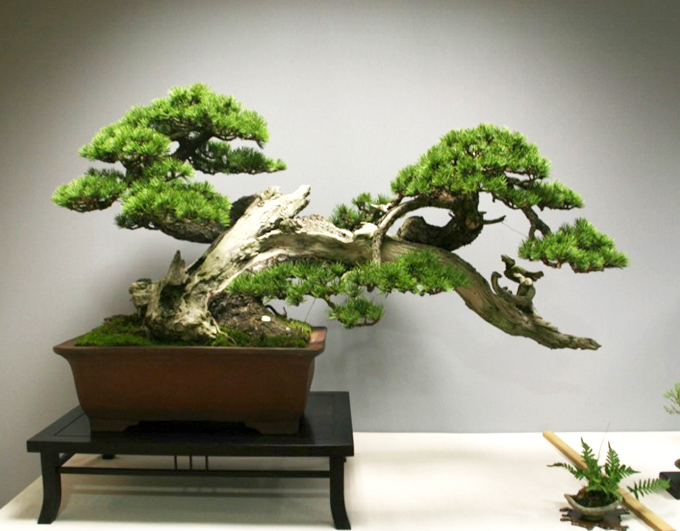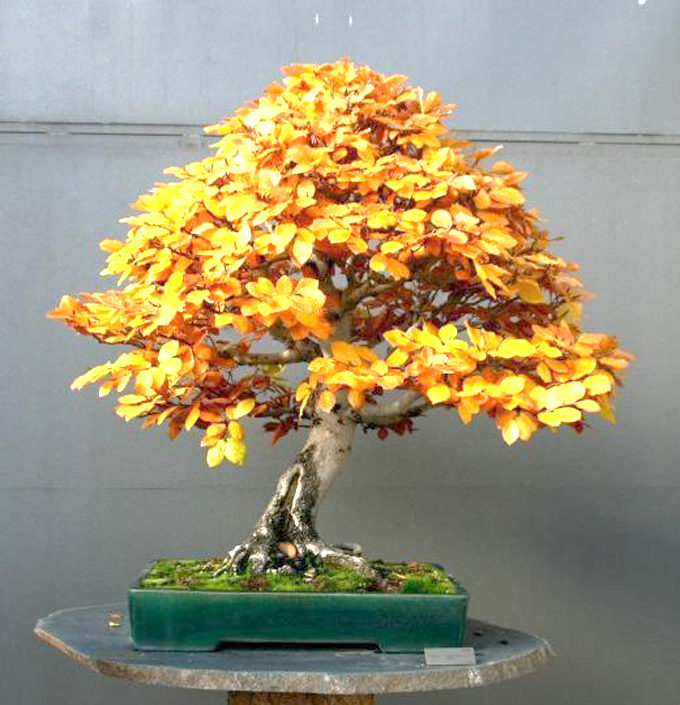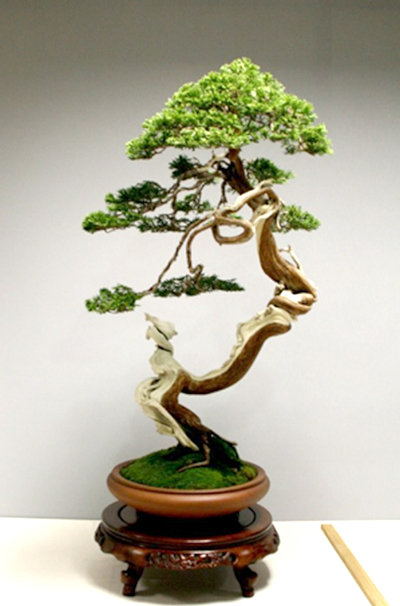 Rather than focus on the more obvious features on this magnificent two headed pine, it might be interesting to take a look at the low foliage that reaches down
Rather than focus on the more obvious features on this magnificent two headed pine, it might be interesting to take a look at the low foliage that reaches down and touches in front of the base of the trunk. Though you might be tempted to remove it and show better show the base of the trunk and the line to the right, still, I think it serves to help bring the eye back to the tree’s balance point, rather than jumping back and forth between the two very strong competing halves of the tree. Another way of approaching this is, if your place your eye at the center of the tree and then you relax your vision (look out from the back of your eyeballs) then you can clearly see the whole tree at once.
Bonsai Center Sopelana. The four trees in this post are all from Bonsai Center Sopelana in the Spanish Basque country (from their website and their facebook photos). Most appeared quite dark on my screen, so I took the liberty of lightening them up a bit. Either way, they are all excellent bonsai. So excellent in fact, that I downloaded several others that we’ll feature soon.
Update! “These (bonsai) are all from the bonsai exhibit in Museo Bonsai de Alcobendas in Madrid.” Courtesy of Nuno Encarnação.
 The whole bottom part of this bonsai; the pot, the moss, the nebari and the scar in the trunk make for a beautiful picture and provide a nice contrast with the colorful top of the tree.
The whole bottom part of this bonsai; the pot, the moss, the nebari and the scar in the trunk make for a beautiful picture and provide a nice contrast with the colorful top of the tree.
 If you hike up to near the tree line in certain places in New Hampshire’s White Mountains, you might see much larger trees that look a lot like this; windswept with lots of deadwood, though they’re mostly Red spruce and Balsam firs, while this one looks like it might be a yew (it’s hard to tell for sure).
If you hike up to near the tree line in certain places in New Hampshire’s White Mountains, you might see much larger trees that look a lot like this; windswept with lots of deadwood, though they’re mostly Red spruce and Balsam firs, while this one looks like it might be a yew (it’s hard to tell for sure).
 This bunjin style tree has a number of idiosyncratic feature that come together into a surprisingly balanced, dynamic tree. A couple things that caught my eye right away; the little deadwood curlycue that’s stacked up where the trunk turns right, the branch that performs a full loop and then appears to split into the two branches that hang down to just above the curlycue and the distinctively patterned deadwood (shari) that runs most of the length of the trunk (this includes the curlyque). There’s more, but enough said for now.
This bunjin style tree has a number of idiosyncratic feature that come together into a surprisingly balanced, dynamic tree. A couple things that caught my eye right away; the little deadwood curlycue that’s stacked up where the trunk turns right, the branch that performs a full loop and then appears to split into the two branches that hang down to just above the curlycue and the distinctively patterned deadwood (shari) that runs most of the length of the trunk (this includes the curlyque). There’s more, but enough said for now.
Hi!
These are all from the bonsai exhibit in Museo Bonsai de Alcobendas in Madrid. This exhibit is the most important bonsai exposition in Spain and one of the three main exhibits in Europe alongside with Noelanders trophy in Belgium and UBI in Italy.
The Museum has also an amazing permanent exposition with some impressive trees with mediterranean species and imported japanese plants, some of which have been previously by such masters as Kobayashi and Kimura. The beech shown in this post is from the permanent exhibit.
The base of the zelkova (?) fairly shouts, “Character!”
Thanks for posting these.
Some amazing trees here. The bunjin is just crazy-good.
And good tip for “seeing.” A method I find helpful is to turn around and step away a few feet, close the eyes, breathe, turn around, open. The first few seconds before the mind engages is a fresh view.
Thank Nuno,
I’ll make that correction right now.
-w
Thanks Steve,
Yes. Given the size of the leaves, Zelkova does make sense.
-w
Thanks Bruce,
I like that ‘fresh view, befor the mind engages.’
-w
Felicidades por los arboles, tuve la oportunidad de estar en Alcobendas, estupendos arboles tanto en la expo como en el museo, pero dos cosas me decepcionaron. 1) Algunos arboles de los premiados no lo merecian no me sirve que digan que el criterio utilizado sean por ser arboles autoctonos, y si es así, que hagan dos selecciones uno para autoctonos y otro para realmente premiar los mejores, intuyo que deben haber amigismos o favoritismos de lo contarrio no lo entiendo. 2) Las demostraciones algunas de ellas realmente decepcionantes.
Gracias Antonio,
Mi Espanol es malo, asi no entiendo todo que usted escribe, pero en resumen, creo qu es: you enjoyed the show but were disappointed with some of the trees (or perhaps the way the trees were displayed).
-w
What type of tree is the second image- orange leaves?
Hello YD
I believe it is a Zelkova.